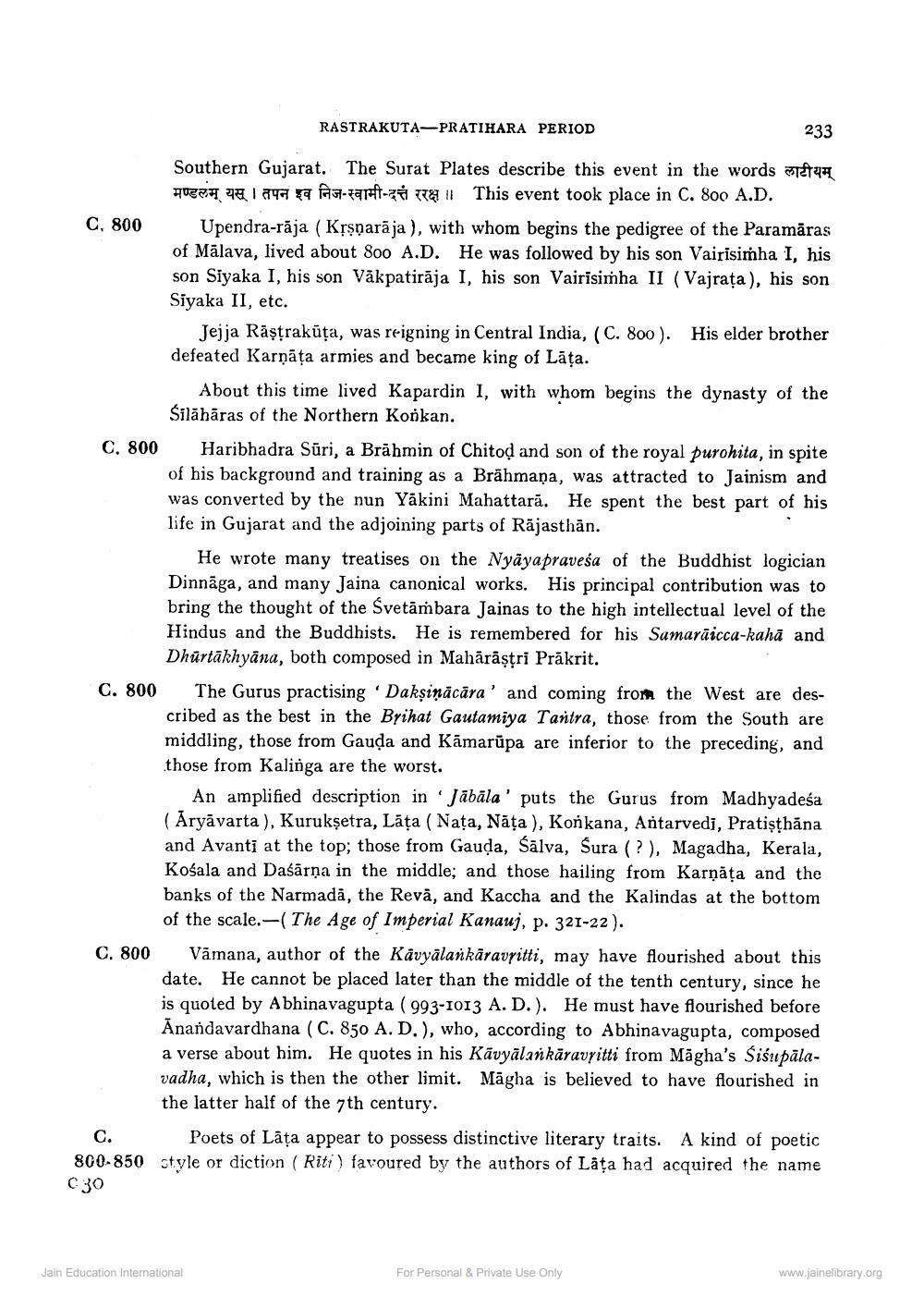________________
RASTRAKUTA-PRATIHARA PERIOD
233
Southern Gujarat. The Surat Plates describe this event in the words &744
HECH 98 1048 - rareft-ze 7 | This event took place in C. 800 A.D. C. 800 Upendra-rāja (Krsnarāja ), with whom begins the pedigree of the Paramāras
of Mālava, lived about 800 A.D. He was followed by his son Vairisimha I, his son Siyaka I, his son Vākpatirāja I, his son Vairisimha II (Vajrata), his son Siyaka II, etc.
Jejja Rāştrakūta, was reigning in Central India, (C. 800 ). His elder brother defeated Karņāța armies and became king of Lāța.
About this time lived Kapardin I, with whom begins the dynasty of the
Šilāhāras of the Northern Konkan. C. 800 Haribhadra Sūri, a Brāhmin of Chitod and son of the royal purohita, in spite
of his background and training as a Brāhmaṇa, was attracted to Jainism and was converted by the nun Yākini Mahattară. He spent the best part of his life in Gujarat and the adjoining parts of Rājasthān.
He wrote many treatises on the Nyāyapraveśa of the Buddhist logician Dinnāga, and many Jaina canonical works. His principal contribution was to bring the thought of the Svetāmbara Jainas to the high intellectual level of the Hindus and the Buddhists. He is remembered for his Samarāicca-kahā and
Dhürtākhyāna, both composed in Mahārāştri Präkrit. C. 800 The Gurus practising Dakşiņācāra' and coming from the West are des
cribed as the best in the Brihat Gautamiya Tantra, those from the South are middling, those from Gauda and Kamarupa are inferior to the preceding, and those from Kalinga are the worst.
An amplified description in Jābāla' puts the Gurus from Madhyadeśa ( Aryāvarta ), Kuruksetra, Lāța (Nața, Nāta ), Konkana, Antarvedī, Pratisthāna and Avanti at the top; those from Gauda, Sālva, Sura (?), Magadha, Kerala, Kośala and Daśārņa in the middle; and those hailing from Karņāța and the banks of the Narmadā, the Reva, and Kaccha and the Kalindas at the bottom
of the scale.-( The Age of Imperial Kanauj, p. 321-22). C. 800 Vāmana, author of the Kavyālankāravritti, may have flourished about this
date. He cannot be placed later than the middle of the tenth century, since he is quoted by Abhinavagupta ( 993-1013 A. D.). He must have flourished before Anandavardhana ( C. 850 A. D.), who, according to Abhinavagupta, composed a verse about him. He quotes in his Kāvyālańkāravyitti from Māgha's Siśupālavadha, which is then the other limit. Māgha is believed to have flourished in
the latter half of the 7th century. C. Poets of Lăța appear to possess distinctive literary traits. A kind of poetic 800-850 ctyle or diction ( Riti) favoured by the authors of Lăța had acquired the name C30
Jain Education International
For Personal & Private Use Only
www.jainelibrary.org




